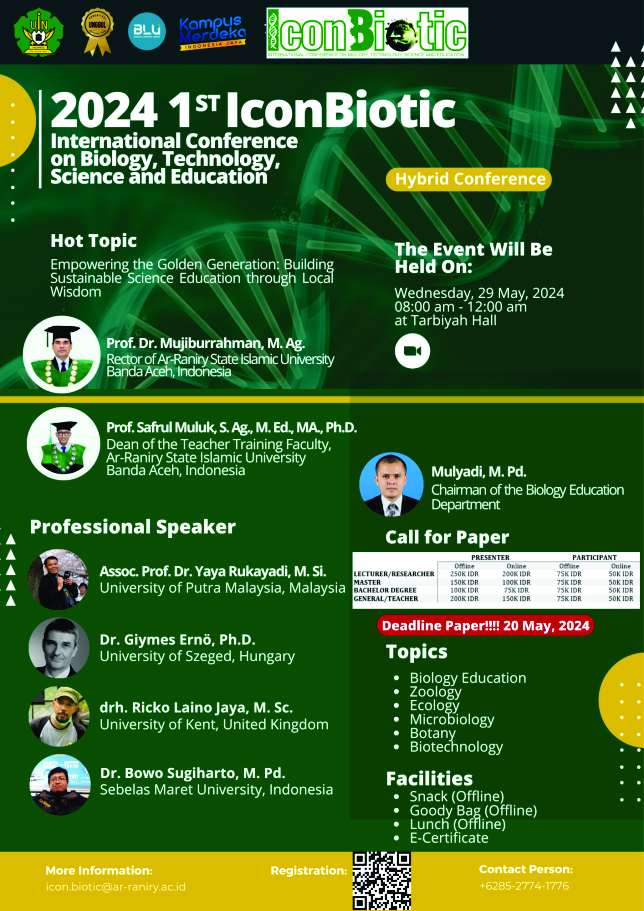EFFICACY TEST OF ARABICA COFFEE LEAF ETHANOL EXTRACT AS A BIOLARVASIDE AGAINST THE VECTOR OF DENGUE HEMORRHAGIC FEVER (DHF)
Keywords:
DHF, Aedes aegypti, Biolarvicide, MortalityAbstract
Dengue fever (DHF) is caused by the dengue virus transmitted through the mosquito vector Aedes aegypti, which is commonly found in tropical areas, including Indonesia. The use of chemical larvicides to eradicate mosquito larvae has resulted in resistant populations, which are toxic to humans and the environment. Arabica coffee leaves (Coffea arabica) contain chemical compounds of alkaloids, saponins, flavonoids, terpenoids, polyphenols that have an important role in killing Aedes aegypti larvae. This study used a completely randomized design (CRD) with each concentration tested in stages, namely 12.5%, 25%, and 50%, with the maceration method using 96% ethanol solvent. This study aims to determine the biolarvicidal potential of ethanol extract of Arabica coffee leaf plants with granule preparations against Aedes aegypti larvae in LT 50 and LT 95 in probit regression analysis and linear regression using the SPSS application. In this study there were three treatment groups, each group had 3 repetitions with concentrations of 12.5%, 25% and 50% respectively. Each repetition is observed in minutes for 24 hours. The results obtained at a concentration of 25% had the highest larval death rate with a percentage of 50.6%, a concentration of 50% with a percentage of 29.3%, then at a concentration of 12.5% with a percentage of 9%.
References
Aliyyu, H. (2023) ‘Gambaran Kasus Demam Berdarah Dengue Pada Usia Anak Sekolah Di Rsud Dr. Drajat Prawiranegara Tahun’, Jurnal Locus Penelitian dan Pengabdian, 2(10), pp. 978–986. doi: 10.58344/locus.v2i10.1813
Amini, R., Santjaka, A. and Setiawan, Y. D. (2018). Status Resistensi Vektor Demam Berdarah Dengue (Aedes aegypti) Terhadap Insektisida Jenis Fenitrothion 1% Di Kabupaten Kudus Provinsi Jawa Tengah Tahun 2017. Buletin Keslingmas, 37(4), pp. 469–474. doi: 10.31983/keslingmas.v37i4.3798.
Anggraini, D. R., Huda, S. and Agushybana, F. (2023). Analisis Perilaku Stakholder Dalam Pelaksanaan Pengendalian DBD di Kota Semarang. Jurnal Ilmu Keperawatan dan Kebidanan, 14(1), pp. 1–6.
Anita Dyah Listyarini and Erni Rosiyanti (2021). Gambaran Perilaku Keluarga Tentang Pencegahan DBD (Demam Berdarah Dengue) di Desa Ngemplak Kecamatan Undaan Kabupaten Kudus’. Jurnal Ilmu Kedokteran dan Kesehatan Indonesia, 1(3), pp. 91–99. doi: 10.55606/jikki.v1i3.265.
Azzahra, J., Narsa, A. C. and Gama, N. I. (2023). Analisis Karakteristik dan Profil Pengobatan Pasien Demam Berdarah Dengue Anak di Instalasi Rawat Inap Rumah Sakit Samarinda Medika Citra Tahun 2020-2021. Jurnal Sains dan Kesehatan, 5(SE-1), pp. 10–18. doi: 10.25026/jsk.v5ise-1.2049.
Marcellia, S., Ulfa, A. M. and Azizah, F. N. (2022). Uji Larvasida Ekstrak Etil
Asetat Dan N-Heksana Daun Kopi Robusta (Coffea Robusta) Terhadap Larva Aedes aegypti. Jurnal Ilmu Kedokteran dan Kesehatan, 8(4), pp. 350–357. doi: 10.33024/jikk.v8i4.4863.
Maulana, S. et al. (2021). Pengaruh Biolarvasid daun Tanaman sebagai Kontrol Vektatau Nyamukaedes Aegypti Penyebab Demam Berdarah: Tinjauan Literatur. Literatur. Jurnal Medika Hutama, 02(01), pp. 402–406.
Panuluh, P. D. (2020). Perbandingan Daya Proteksi Ekstrak Daun Kopi Dengan Ekstrak Kulit Buah Kopi Robusta (Coffeacanephora) Sebagai Repelan Nyamuk. Prosiding Seminar FMIPA Unila, 2507(February), pp. 1–9. Available at: http://digilib.unila.ac.id/id/eprint/61284.
Rusli Abdullah et al. (2023). Penyuluhan Tentang Penyakit Demam Berdarah (DBD) Di Wilayah Kerja Puskesmas Macini Sawah Kota Makassar. Jurnal ABDIMAS Panrita, 4(1), pp. 9–16. doi: 10.37362/jap.v4i1.974.
Susanti, L. and Boesri, H. (2012). Insektisida Sipermethrin 100 G/L Terhadap Nyamuk Dengan Metode Pengasapan. KESMAS - Jurnal Kesehatan Masyarakat, 7(2), pp. 156–163. doi: 10.15294/kemas.v7i2.2812.
Wila, R. W. and Nusa, R. (2020). Gambaran Klinis dan Respon Imun Penderita Demam Berdarah Dengue di Rumah Sakit Kristen Lindi Mara Sumba Timur Selama Bulan Januari Sampai dengan Desember 2018. Balaba: Jurnal Litbang Pengendalian Penyakit Bersumber Binatang Banjarnegara, pp. 209–216. doi: 10.22435/blb.v16i2.2816.
Yupita, Frsilia, M. and Indriani (2022). Hubungan Motivasi Terhadap Perilaku Pemberantasan Sarang Nyamuk Demam Berdarah Dengue (DBD) Relationship Of Motivation to Conduct The Suppression Of Dengue Mosquito Nest Dengue (DBD). Jurnal Surya Medika, 8, pp. 151–155. Available at: http://journal.umpalangkaraya.ac.id/index.php/jsm.















